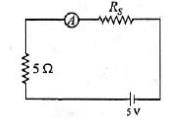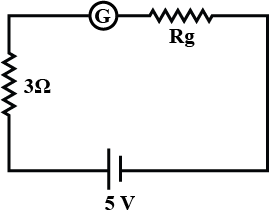NCERT Based Test: The Moving Coil Galvanometer - CUET MCQ
15 Questions MCQ Test - NCERT Based Test: The Moving Coil Galvanometer
In a moving coil galvanometer the deflection (ϕ) on the scale by a pointer attached to the spring is
Two moving coil meters, M1 and M2 ave thhe following particulars:
R1 = 10 Ω, N1 = 30, A1 = 3.6 × 10–3 m2, B1 = 0.25 T
R2 = 14 Ω, N2 = 42, A2 = 1.8 × 10–3 m2, B2 = 0.50 T
The spring constants are identical for the two meters. What is the ratio of current sensitivity and voltage sensitivity of M2 and M1.
R1 = 10 Ω, N1 = 30, A1 = 3.6 × 10–3 m2, B1 = 0.25 T
R2 = 14 Ω, N2 = 42, A2 = 1.8 × 10–3 m2, B2 = 0.50 T
The spring constants are identical for the two meters. What is the ratio of current sensitivity and voltage sensitivity of M2 and M1.
If the current sensitivity of a galvanometer is doubled, then its voltage sensitivity will be
A moving coil galvanometer can be converted into an ammeter by:
A galvanometer of resistance 70Ω, is converted to an ammeter by a shunt resistance rs = 0.03Ω. The value of its resistance will become
If the galvanometer current is 10mA, resistance of the galvanometer is 40Ω and shunt of 2Ω is connected to the galvanometer, the maximum current which can be measured by this ammeter is
A galvanometer of resistance 40Ω gives a deflection of 5 divisions per mA. There are 50 divisions on the scale. The maximum current that can pass through it when a shunt resistance of 2Ω is connected is
In the given circuit, a galvanometer with a resistance of 70Ω is converted to an ammeter by a shunt resistance of 0.05Ω total current measured by this device is
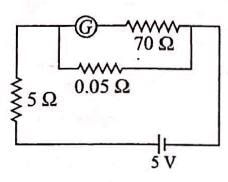
A galvanometer having a resistance of 50Ω, gives a full scale deflection for a current of 0.05A. The length (in metres) of a resistance wire of area of cross section 3 × 10−2cm2 that can be used to convert the galvanometer into an ammeter which can read a maximum of 5A current is
(Specific resistance of the wire ρ = 5 × 10−7Ωm)
The conversion of a moving coil galvanometer into a voltmeter is done by
A galvanometer of resistance 10Ω gives full-scale deflection when 1mA current passes through it. The resistance required to convert it into a voltmeter reading upto 2.5V is
A voltmeter which can measure 2V is constructed by using a galvanometer of resistance 12Ω and that produces maximum deflection for the current of 2mA, then the resistance R is
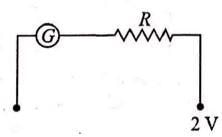
The value of current in the given circuit if the ammeter is a galvanometer with a resistance RG = 50Ω is
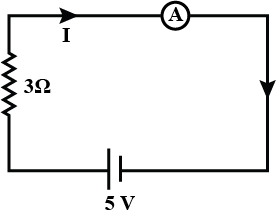
A galvanometer coil has a resistance of 15Ω and the metre shows full scale deflection for a current of 4mA. To convert the meter into a voltmeter of range 0 to 18V, the required resistance is
A galvanometer of resistance 50Ω is connected to a battery of 3V along with a resistance of 2950Ω in series. A full-scale deflection of 30 divisions is obtained in the galvanometer. In order to reduce this deflection to 20 divisions, the resistance in series should be:




















